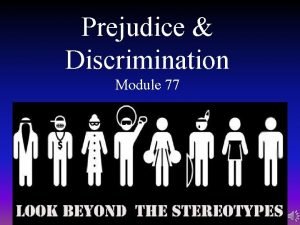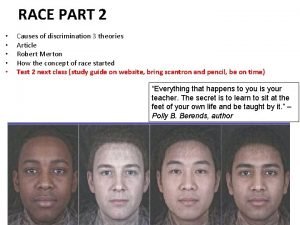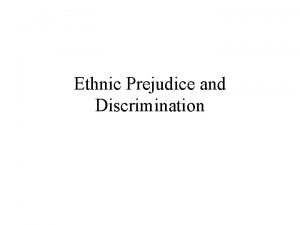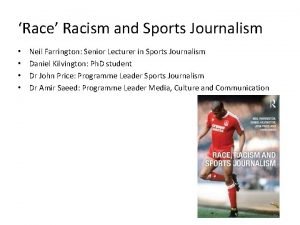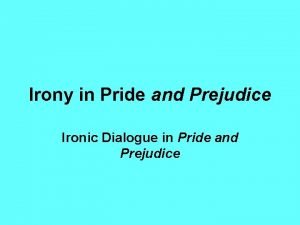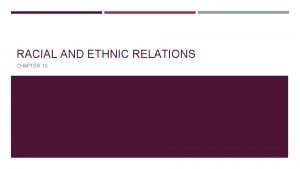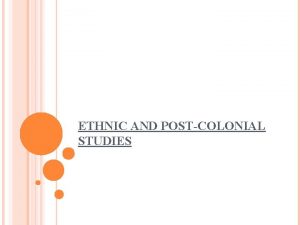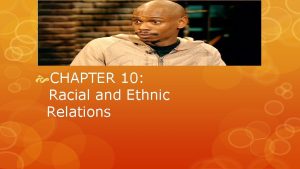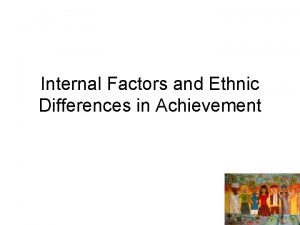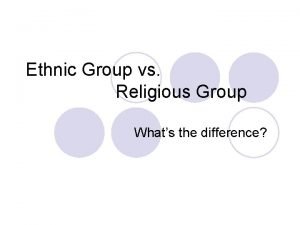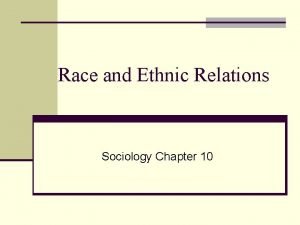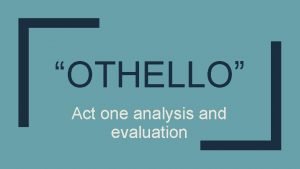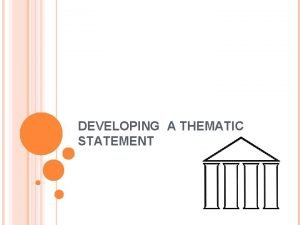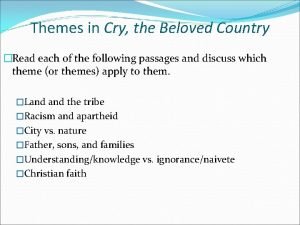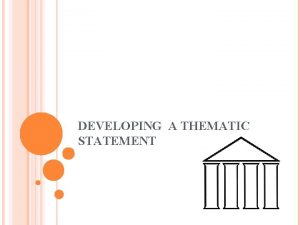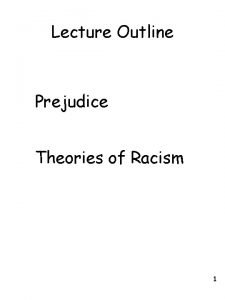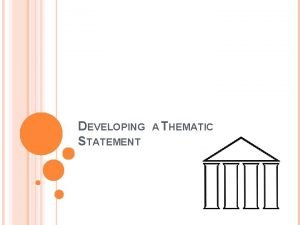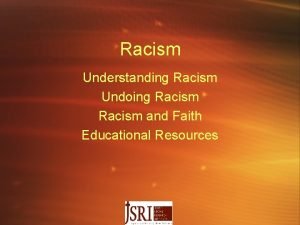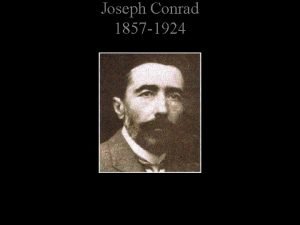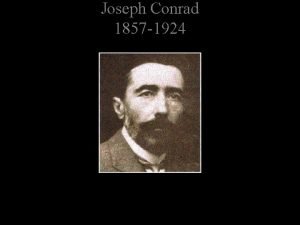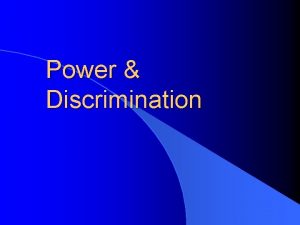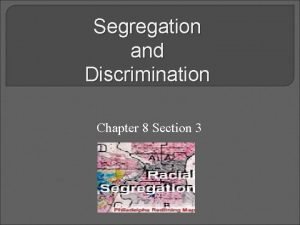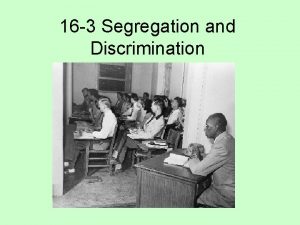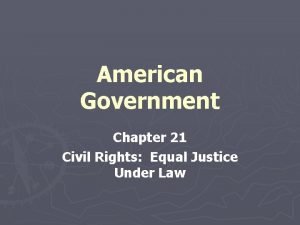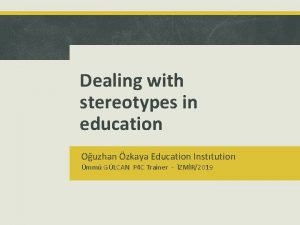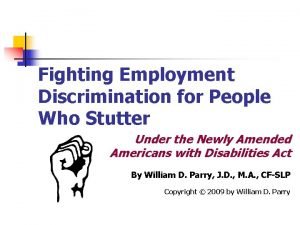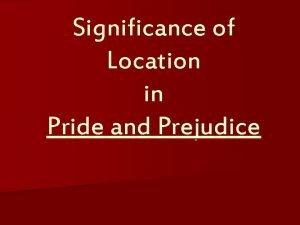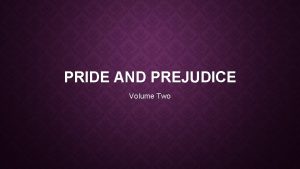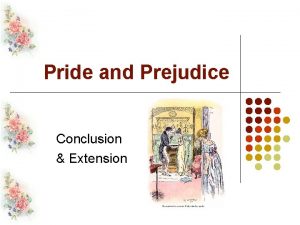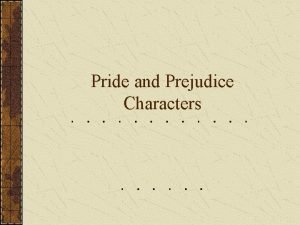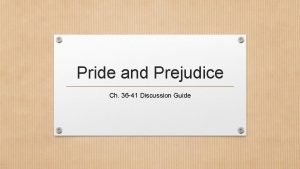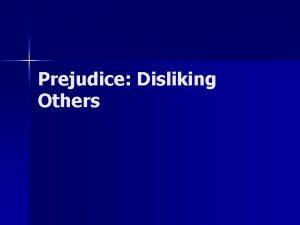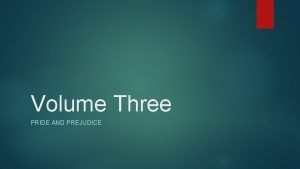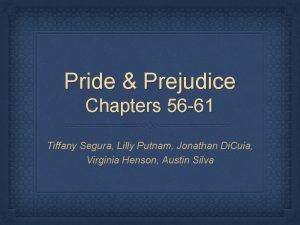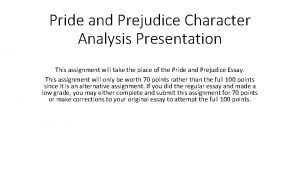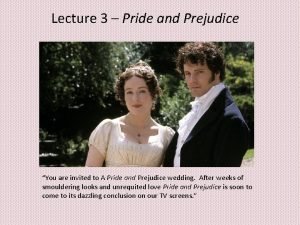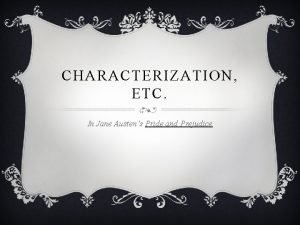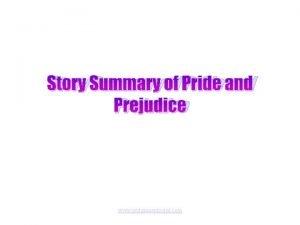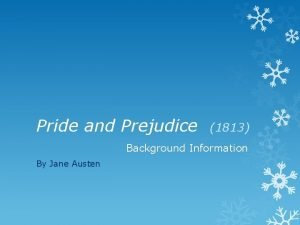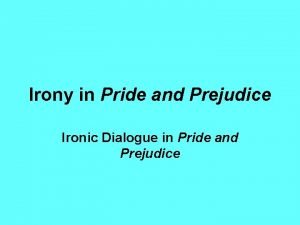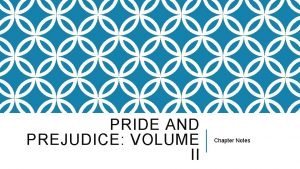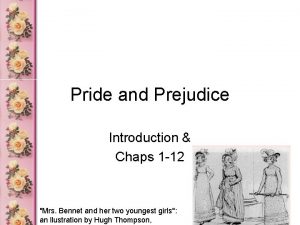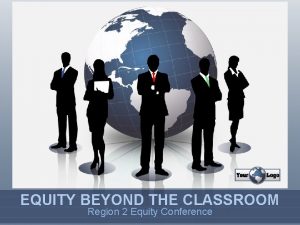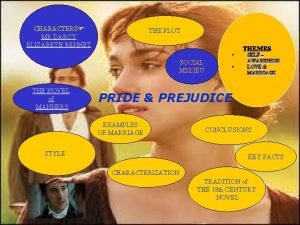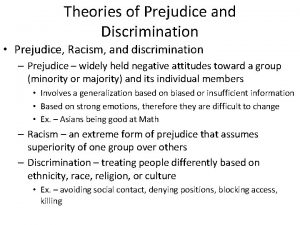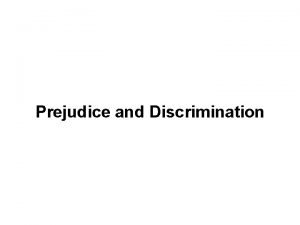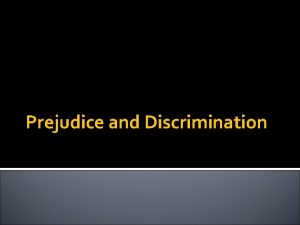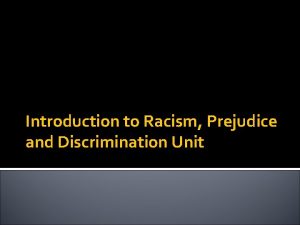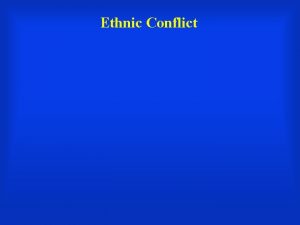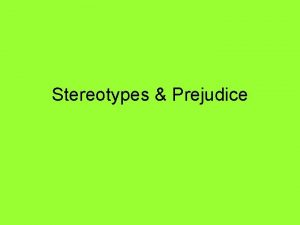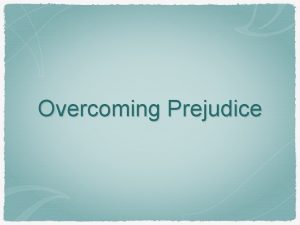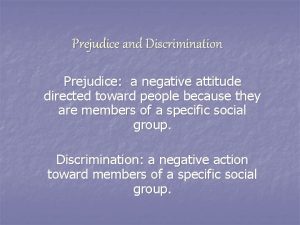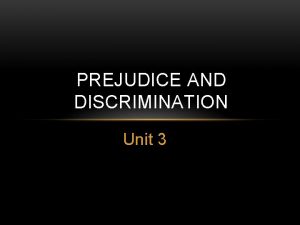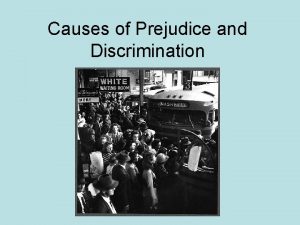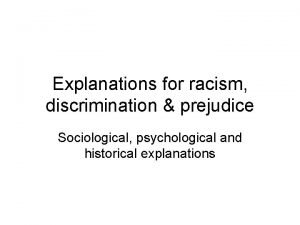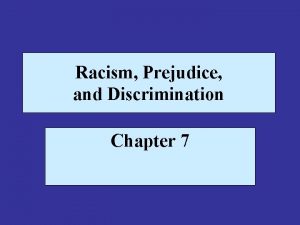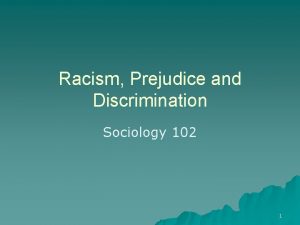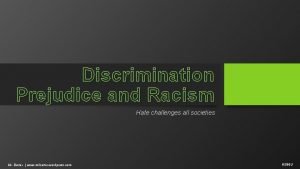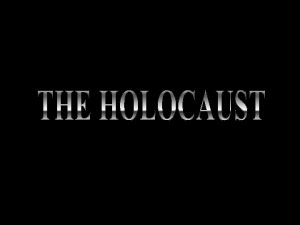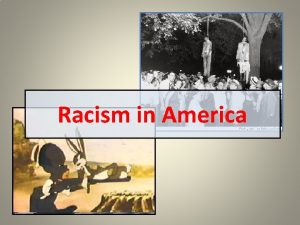Ethnic Prejudice and Discrimination Racism Racism is generally
































































- Slides: 64

Ethnic Prejudice and Discrimination

Racism • Racism is generally understood as either belief that different racial groups are characterized by intrinsic characteristics or abilities and that some such groups are therefore naturally superior to others. • See Biology as Ideology

Xenophobia • A specific form of racism involving insiders and outsiders…See Howard Becker (1963) • Vilfred Pareto 1848 -1923

Xenophobia • A fear that “outsiders” are taking over the place. . • Xenophobia occurs among those who conceive of themselves as “the insiders” • See “Nativism and Social Closure” International Journal of Comparative Sociology.

Orangeism • In 19 th century Toronto, Orange Order (pro Protestant, Pro British, Anti-Catholic faternity • Worried about the influx of Roman Catholics from Ireland to Canada and the US. • Orangeman create “social closure” to demonstrate their superiority and right to dominate.

Toronto Star • For example, a Toronto Star article published on 14 July 2006 authored by Daniel Stoffman noted that 43% of immigrants move to the Greater Toronto Area and said "unless Canada cuts immigrant numbers, our major cities will not be able to maintain their social and physical infrastructures".

Myths • -Immigrants taking over the country • 1986 16% of population were immigrants the same figure reported in 1951. • Quite a bit less than 22% reported in 1911. • 40% of 200, 000 per year through Family Reunification.

Immigrants are uneducated • - NO- immigrants are more likely than nonimmigrants to have a university education. • • -However, more immigrants have less than grade 9 at 23% compared to 16% among non immigrants- • Due to low educational levels of women. patriarchy rather than ignorance. •

From Asia/South Asia • -Immigrants from Asia are taking over the country. • -I. epeople from Asia -East Indian, Pakistan, China, Korea ect. are overrunning the country pretty soon there will be no white folks. • This is an urban myth & unfounded… •

Visible Minorities • -It is true that 40% of immigrants living in Canada came from these areas between 1978 and 1986. • However, in terms of proportion in Canada they only constitute 3% of the total population. • Currently, immigrants 11% of the pop . . (2006)

“Sap the welfare system” • -Immigrants come over and sap the welfare system. NO. • Immigrants are only slightly less likely to participate in the labour force 76. 4 compared to 77. 7%

Labour force participation • Among young people-able bodiedimmigrants had a higher labour force participation rate at 95. 3% compared to 94. 8 among non-immigrants. • -Immigrant men earn more than nonimmigrant men, although the same is not true for women. (pink collar/pink ghetto)

2006 Census Canadian Population Total 31, 241, 030 Canadian Non Imm Populati 24, 788, 720 Canadian Immigrant Current 6, 186, 950 • Canadian Immigr pre 1991 3, 408, 420

Racism • • • INVOLVES various combinations: Stereotyping Prejudice Discrimination Self Fulfilling Prophecy Labeling

Stereotypes, Prejudice and Discrimination • To focus upon stereotyping, prejudice and discrimination requires a socialpsychological level of analysis • Social psychology is the study of how people and groups interact. • Micro sociological approach, small group dynamics

Definitions 1. STEREOTYPE- refers to images in our heads that compensate for the limits of human perceptions. Stereotype-prejudicial views or descriptions of categories of people

PREJUDICE 2. Prejudice -a rigid irrational generalization about an entire category of people • -an aversion fueled by ignorance. • -social/psychological & personal identity issues -faulty content of stereotypes. •

Discrimination 3. Discrimination- treating various categories of people unequally • DISCRIMINATION- exists when ethnic or racial group members are denied equal treatment. • The concept is often used unreflectively

Merton, R. K. (1948). The Selffulfilling Prophecy • Developed a typology of prejudice and discrimination which suggested that they vary independently of one another

Merton’s Typology • According to Merton there were four logical relationships between prejudice and discrimination: • 1. Un-prejudice non -discriminators. • 2. Prejudiced discriminators. • 3. Unprejudiced discriminators. • 4. Prejudiced non-discriminators

Merton’s Research • Merton suggested that sociologists must distinguish between actual and perceived discrimination. • Perceived definitions derive from labels. • Labelling can lead to a self fulfilling prophecy. • Is there an objective measure?

The self-fulfilling prophecy • Is a false definition of the situation evoking a new behaviour which makes the original false conception come 'true'. • This specious validity of the self-fulfilling prophecy perpetuates a reign of error. .

. Frustration-Aggression hypothesis. Gordon Alport The ABCs of Scapegoating (1948) and in a 1954 book entitled The Nature of Prejudice

Scapegoating • (from the verb "to scapegoat ") is the practice of singling out any party for unmerited negative treatment or blame as a scapegoat.

Scapegoating • Scapegoating, displaced anger directed towards another group. Frustration/Aggression hypothesis holds that from frustration or blockage the individual directs his frustration on to other groups.

Scapegoating Social Psychology • Gordon Alport develops a social psychological profile of the relationship between: 1. Frustration (ie. Economic) 2. Aggression (hate crimes) 3. Social Outcomes

Frustration/Aggression Hypoth: 9 points • 1. Every person faces a cluster of propelling forces directing them to certain goals. • 2. No person can attain all the goals he/she sets out for him/herself and therefore major and minor frustrations develop. • Achievements can be blocked by a lack of skills, by other persons, by illness etc.

Frustration/Aggression Hypoth: • 3. The blockage of goals leads to frustration within individuals. • • 4. Often these cannot be directed towards a clear source of frustration.

Frustration/Aggression Hypoth: • 5. Hostility is then directed towards a source which cannot fight back. • • 6. The person then looks for a justification for this scapegoating attitude. • 7. He creates or accepts convincing reasons (ideologies) for hating or discriminating against the object of his/her hostility.

Frustration/Aggression Hypoth: • • 8. Discovers and believes many kinds of evidence that prove that the object of aggression deserve the treatment they receive. (Ideology)

• • 9. He projects upon the scapegoat some of the evil behaviour that characterize himself and his own behaviour. (behaviour)

Forms of Discrimination in Canada Overt, Structural and Covert

1. Blatant or Overt. Blatant discrimination is to… arbitrarily deny opportunities to members of ethnic groups whose qualifications are equal to members of the dominant group.

2. Structural • - The impersonal `perhaps’ unintentional operation of the Canadian social system. • -The exclusion of a substantial number of members of some ethnic minorities from the full participation in public life. • The unequal distribution of opportunities and rewards.

3. Legislative discrimination • -Phased out after WW 2 I. e Internment camps • Yet until mid 1960's, some of Canadian immigration laws were racist. • E. g. policies regarding aboriginal peoples have historically been paternalistic.

4. Cultural Discrimination • Operates through the expectations of the dominant culture and its attempts at conformity in public life.

Cultural Discrimination • Those groups whose attributes (symbols, artifacts, cultural practices) that deviate most markedly from the dominant group are the most severely discriminated against

Cultural Discrimination • Ethnic groups that approximate the dominant ethno-cultural model in appearance, religion, lifestyle symbols etc. the more open and accessible are the institutions of society.

5. Cultural Discrimination in Education • Nowhere is cultural discrimination more evident than in the hidden curriculum of the Canadian educational system. • John Dewey University of Chicago (1894 -1904

ON THE ONE HAND: • Education is a formalized aspect of acculturation. • A person develops the skills and life ways appropriate for adult participation in the society. • •

Hidden Curriculum • Much of what teachers convey in this regard is based upon the norms of the dominant, white, urban, middle class. • • Students of lower social classes or minority groups may not easily identify with models offered by teachers.

See Henry and Tator on Democratic Racism • In a multi-cultural society like Canada failure to depict the ethnic diversity of Canada through the educational system may be seen a violation of the basic human rights of ethnic students.

6. Discrimination of Silence • Refers to where people in power say or do nothing about racism in Canada. • -Fear of discussing, let alone teaching principles of human rights. • -Silence perpetuates the status quo preserving racist thinking and victim blaming.

Social distance Research • Indicates that knowledge of racism and prejudice alone does not necessarily change behaviour nor generate positive self images. • The key variables are distance, contact, integration.

Social distance (Moreland, Levine, & Wingert, 1996). • Where social distance is high the relations between groups tends to be impersonal. • Insiders relate to outsiders in terms of stereotypes rather than individual personalities. •

High Social Distance • Groups do not get close enough to outsiders to test the accuracy of their preconceived, unsubstantiated assumptions.

Social distance low • Social relationships are more intimate, more individualized. • People become aware of similarities rather than differences. This allows differences to be celebrated rather than to be looked upon negatively. • Individuals are then looked upon on a personal level as equals & individual human personalities.

Reducing Discrimination • Educational programs designed to reduce ethnic prejudice must be aimed at reducing social distance between members of different ethnic groups. • • The promotion of contact between groups enables members to share mutual similarities as well as celebrate differences.

R. C. Lewotin • “There is not one iota of evidence of any kind that differences in status, wealth and power between races in North America have anything to do with genes”. (Brym 1999: 64) • 85 percent of all variation is between 2 individuals • 8 percent between ethnic groups • 7 percent between races

Biology as Ideology • R. C Lewontin in his book, Biology as Ideology: The Doctrine of DNA (1991) sums it up this way: •

IDEOLOGY • Conflict theorists define ideology as a body of assumptions, ideas, and values the combine into a coherent world view. • Marx and Engels-ideas are social creations, the appropriating class gives dominance in the ideological as well as the economic sphere.

Summary I. • Prejudice and discrimination are categories of sociological research requiring a social psychological focus. • Many myths can be generated by social distance, misunderstanding and inaccurate statistical data.

Summary II. • There are various forms of discrimination (action) within the Canadian system • Some structural and systemic, • Other cultural and symbolic. • Discrimination is the result of prejudice and stereotyping in action.

Ethnic Extremist Canada

Canadian Racial Supremacism • The Contemporary Structure of Canadian Racial Supremacism: Networks, Strategies and New Technologies • Sean P. Hier • Canadian Journal of Sociology / Cahiers canadiens de sociologie, Vol. 25, No. 4 (Autumn, 2000), pp. 471 -494 (article consists of 24 pages) • Published by: Canadian Journal of Sociology •

Contemporary Structure • The Contemporary Structure of Canadian Racial Supremacism: Networks, Strategies and New Technologies, by Sean P. Hier © 2000

Abstract • In the past five years, public debate has ideology of racial supremacism. • Right Wing-exclusion, social closure, racism • Left Wing-inclusion, collectivism, social welfare in a competive, capitalistic context

Canada's racial supremacists • In addition to updating the body of literature concerned with Canada's racial supremacists, three arguments are presented • First, there exists a considerable gap between the public images that racial supremacist groups attempt to present on the internet and a far less benign image that emerges upon closer analysis

• Second, exemplified by the Freedom-Site, the internet has facilitated a greater degree of solidarity between racial supremacist organizations

• Third, given the impersonal nature of the internet, there exists a certain degree of danger that otherwise ordinary citizens will become more susceptible to the ideology of racial supremacism

• Review of literature by drawing on data gathered from an investigation of the Freedom-Site, a racial supremacist Web site run out of Toronto, Ontario, Canada

In 2001 • In 2001, 250, 640 people immigrated to Canada. • Based on the Canada 2001 Census total population of 30, 007, 094 people, immigration represented 0. 834% population growth that year

Point System • • 1. Education 5 -25 H. S. -Ph. D 2. Official language knowledge English, French 3. Work experience 15 -21 1 -4 years 4. Age 10 -21 -49 years 5. Arranged Employment 0 - HRSDC confirmed 6. ‘Adaptability’ 0 -10* * Spouse education, Canadian education or experience, family contacts

2001 Census • Data from the 2001 Census show that between 1991 and 2000 alone, • 2. 2 million immigrants were admitted to Canada, the highest number for any decade in the past century.
 Module 77 prejudice and discrimination
Module 77 prejudice and discrimination Allport's scale diagram
Allport's scale diagram Merton's typology of prejudice and discrimination
Merton's typology of prejudice and discrimination Prejudice
Prejudice Shakespeares tragedy about racism and jealousy
Shakespeares tragedy about racism and jealousy Othello racism theme
Othello racism theme Racism and slavery
Racism and slavery Neil farrington
Neil farrington Irony pride and prejudice
Irony pride and prejudice Chapter 10 racial and ethnic relations
Chapter 10 racial and ethnic relations Ethnicity in postcolonialism
Ethnicity in postcolonialism Chapter 10 racial and ethnic relations
Chapter 10 racial and ethnic relations Ethnocentric curriculum
Ethnocentric curriculum Whats ethnic group
Whats ethnic group How are ethnic groups and religious groups related
How are ethnic groups and religious groups related Chapter 10 racial and ethnic relations review worksheet
Chapter 10 racial and ethnic relations review worksheet Explain miss maudie's cake portions
Explain miss maudie's cake portions Who are the mrunas in to kill a mockingbird
Who are the mrunas in to kill a mockingbird Devour up my discourse
Devour up my discourse Racism thematic statement
Racism thematic statement Cry the beloved country themes
Cry the beloved country themes Racism in huckleberry finn essay
Racism in huckleberry finn essay Racism thematic statement
Racism thematic statement What do about racism
What do about racism Racism scale
Racism scale Whats a theme statement
Whats a theme statement How does aunt alexandra treat calpurnia
How does aunt alexandra treat calpurnia Understanding racism
Understanding racism Heart of darkness part 3
Heart of darkness part 3 Heart of darkness racism quotes
Heart of darkness racism quotes The poem dreaming black boy
The poem dreaming black boy Discrimination power meaning
Discrimination power meaning Chapter 16 section 3 segregation and discrimination
Chapter 16 section 3 segregation and discrimination Chapter 8 section 3 segregation and discrimination
Chapter 8 section 3 segregation and discrimination In what regions did the literacy test exist
In what regions did the literacy test exist Government chapter 21 diversity and discrimination
Government chapter 21 diversity and discrimination Diversity and discrimination
Diversity and discrimination Jobs for people who stutter
Jobs for people who stutter Brightness adaptation and discrimination
Brightness adaptation and discrimination Locations in pride and prejudice
Locations in pride and prejudice Volume 2 pride and prejudice
Volume 2 pride and prejudice Pride and prejudice volume 3
Pride and prejudice volume 3 Pride and prejudice chapter 52 summary
Pride and prejudice chapter 52 summary Pride and prejudice conclusion
Pride and prejudice conclusion Pride and prejudice character names
Pride and prejudice character names Pride and prejudice chapter 43
Pride and prejudice chapter 43 Historical background of pride and prejudice
Historical background of pride and prejudice Nature and power of prejudice
Nature and power of prejudice Pride and prejudice chapter 59
Pride and prejudice chapter 59 Pride and prejudice chapter 56
Pride and prejudice chapter 56 Elizabeth pride and prejudice character analysis
Elizabeth pride and prejudice character analysis Manners in pride and prejudice
Manners in pride and prejudice Catherine belsey books
Catherine belsey books Indirect characterization in pride and prejudice
Indirect characterization in pride and prejudice Why does lydia marry wickham
Why does lydia marry wickham Pride and prejudice background
Pride and prejudice background Irony in pride and prejudice
Irony in pride and prejudice Pride and prejudice jane eyre
Pride and prejudice jane eyre Pride and prejudice chapter 30 summary
Pride and prejudice chapter 30 summary Introduction of pride and prejudice
Introduction of pride and prejudice Pride and prejudice introduction
Pride and prejudice introduction Amiable definition sentence
Amiable definition sentence Bias for in favor of
Bias for in favor of Pride and prejudice plot diagram
Pride and prejudice plot diagram Vivado
Vivado
